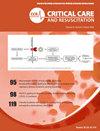一项随机、对照、可行性试验,比较危重成人患者外周静脉输注血管加压剂与中心静脉输注血管加压剂:VIPCA试验
IF 1.7
4区 医学
Q3 CRITICAL CARE MEDICINE
引用次数: 0
摘要
目的:确定开展一项明确的随机试验的可行性,以确定在需要重症监护病房住院的危重患者中,与晚期CVC插入相比,早期CVC插入是否会导致治疗后30天(DAH-30)存活天数和院外天数增加。设计、环境和参与者我们进行了一项单中心、平行组、可行性随机对照试验,接受血管加压剂输注的危重患者按1:1的比例随机分为早期(4小时内)或晚期(12小时后)接受血管加压剂输注。所有患者在等待血管加压剂输注的同时,均通过外周静脉插管(PIVC)接受血管加压剂输注。主要临床结果为DAH-30,主要可行性结果通过评估方案依从性、招募率、符合条件患者的随机化、保留、随访和缺失数据来评估。结果2023年1月至2024年5月共入组患者40例,每组20例。早期CVC组的方案依从性(55%)明显低于晚期CVC组(100%,p <;0.001)。早期CVC组到CVC插入的中位时间为3.3 h(四分位间距(IQR) 1.2-3.7 h),在4小时的目标范围内。早期和晚期CVC组的中位数(IQR)分别为13.5(0.0 ~ 23.5)和19.0 (5.0 ~ 23.0)DAH-30 (P = 0.18)。两组间PIVC并发症相似,均无严重并发症。试验期间插入的18例cvc无并发症发生。结论早期CVC的治疗方案依从性明显低于晚期CVC。为了能够进行更大规模的确定试验,将需要对方案进行一些修改。试验注册actrn12621000721808(澳大利亚新西兰临床试验注册)。本文章由计算机程序翻译,如有差异,请以英文原文为准。
A randomised, controlled, feasibility trial comparing vasopressors infused via peripheral cannula versus central venous access for critically ill adults: The VIPCA trial
Objective
To determine the feasibility of conducting a definitive randomised trial to determine whether, in critically ill patients requiring intensive care unit admission, early CVC insertion compared with late CVC insertion leads to increased days-alive-and-out-of-hospital at 30 days (DAH-30) post-treatment.
Design, settings and participants
We conducted a single-centre, parallel-group, feasibility randomised controlled trial with critically ill patients receiving vasopressor infusions randomised in a 1:1 ratio to receive early CVC insertion (within 4 h) or late CVC insertion (after 12 h). All patients received vasopressor infusions via a peripheral intravenous cannula (PIVC) while awaiting CVC insertion. The primary clinical outcome was DAH-30 and the primary feasibility outcome was assessed by evaluating protocol adherence, rates of recruitment, randomisation of eligible patients, retention, follow-up and missing data.
Results
We enrolled 40 patients, 20 patients per group between January 2023 and May 2024. Protocol adherence was significantly lower in the early CVC group (55 %) compared to the late CVC group (100 %, p < 0.001). The early CVC group had a median time to CVC insertion of 3.3 h (interquartile range (IQR) 1.2–3.7 h), within the 4-h target. The early and late CVC groups had a median (IQR) of 13.5 (0.0–23.5) and 19.0 (5.0–23.0) DAH-30 respectively (P = 0.18). PIVC complications were similar between the two groups with no severe complications. There were no complications among the 18 CVCs inserted during the trial.
Conclusions
Protocol adherence in the early CVC was much lower than the late CVC. Some protocol modifications will be required to enable the conduct of a larger-scale definitive trial.
Trial Registration
ACTRN12621000721808 (Australia New Zealand Clinical Trials Registry).
求助全文
通过发布文献求助,成功后即可免费获取论文全文。
去求助
来源期刊

Critical Care and Resuscitation
CRITICAL CARE MEDICINE-
CiteScore
7.70
自引率
3.40%
发文量
44
审稿时长
>12 weeks
期刊介绍:
ritical Care and Resuscitation (CC&R) is the official scientific journal of the College of Intensive Care Medicine (CICM). The Journal is a quarterly publication (ISSN 1441-2772) with original articles of scientific and clinical interest in the specialities of Critical Care, Intensive Care, Anaesthesia, Emergency Medicine and related disciplines.
The Journal is received by all Fellows and trainees, along with an increasing number of subscribers from around the world.
The CC&R Journal currently has an impact factor of 3.3, placing it in 8th position in world critical care journals and in first position in the world outside the USA and Europe.
 求助内容:
求助内容: 应助结果提醒方式:
应助结果提醒方式:


